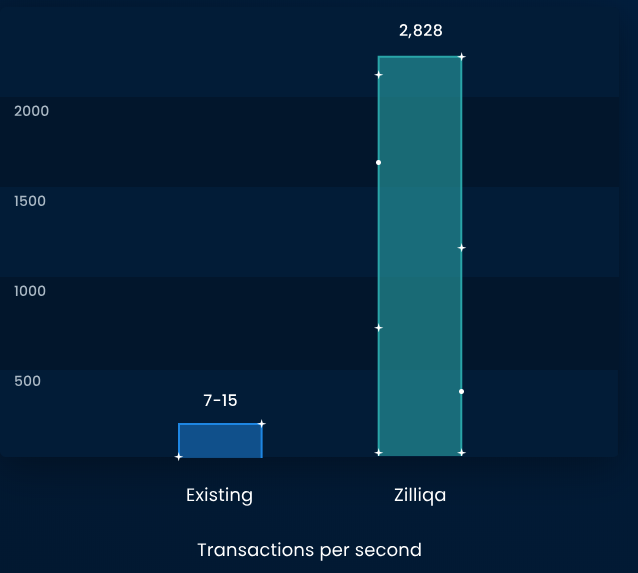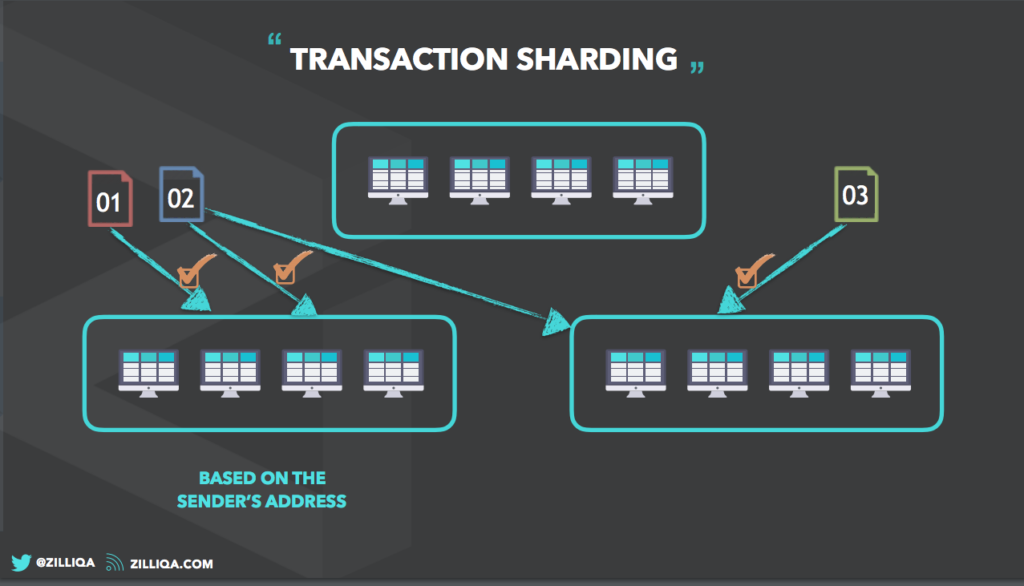Last week, I was able to interview Zillaqa CEO, Xinshu Dong. As of the writing of this article, Zilliqa (ZIL) is sitting at #32 on CoinMarketCap with a market capitalization of just over $270 million. The currency peaked at over $1.6 billion in May of 2017. The coin’s meteoric rise occurred as bitcoin was hovering around the $8,000 level and it has historically performed exceptionally well even in bear markets.
What is Zilliqa?

Zilliqa is a new high-throughput blockchain that aims to “process thousands of transactions per second” with “high decentralization and high security.” The aim of this high throughput is that developers “can focus on developing… [their]ideas without worrying about network congestion, high transaction fees or security which are the key issues with legacy blockchain platforms.” The website contains the graph to the left comparing Zilliqa to existing blockchains.
This is not to say other blockchains cannot process higher transaction volumes, Dong says, but the question is what these other blockchains sacrifice in order to increase their transaction throughput. Other blockchains achieve this end by having slightly more centralized architecture, or by having some transactions running off the blockchain. The Zilliqa team does not compromise with these performance enhancements, with Dong saying that the team “believes in the original spirit of [the]blockchain,” which means they “process things on the blockchain itself” and “maintain a very high level of decentralization.” Instead, most of their performance enhancements come either through sharding or through working on their consensus algorithm to be more efficient. Dong says with every transaction as many as 600-800 nodes are involved. He goes on to explain how this differs from Ethereum and Bitcoin.
With Ethereum and Bitcoin, Dong says, you’ll have between 10,000 and 20,000 nodes all processing every transaction. While the process is very secure and resilient it is not necessarily efficient. With Zilliqa, the challenge was making sure not every node had to process every transaction, but at the same time making sure a large enough number of nodes are involved to achieve decentralization in an efficient way. The way this is done at Zilliqa (and how it has been proposed at Ethereum) is through sharding. At a high level, sharding means spreading out transactions over a number of different nodes so that not every node is doing every transaction. There are several types of sharding currently out there and what Zilliqa is doing immediately is what’s called network or transaction sharding and is different from state sharding, which is done at Ethereum.
Sharding at Zilliqa vs Sharding at Ethereum
While Dong explains state sharding in the interview, the best explanation I found was in a paper by chief scientific advisor at Zilliqa Prateek Saxena, and advisor Loi Luu (who also happens to be an advisor to Kambria, Republic Protocol, and TraceTo.io) and several others who do not appear to be involved with the Zilliqa project anymore (namely Viswesh Narayanan, Chaodong Zheng, Kunal Baweja, and Seth Gilbert) all at the National University of Singapore. The following excerpt from the paper explains how it works:
“ZILLIQA does what is called network or transaction sharding. Imagine a sample network of 1,000 nodes. ZILLIQA will automatically divide the network into 10 shards each with 100 nodes. Each shard can now process transactions in parallel. If each shard is capable of processing 100 transactions per second, then all shards together can process 1000 transactions per second. The ability to process transactions in parallel due to the sharded architecture ensures that the throughput in ZILLIQA increases (roughly) linearly with the size of the network.”
The paper goes on to explain how this is different from what is being researched at Ethereum:
“Ethereum is currently researching on what is called state sharding, i.e., how to divide the blockchain state so that storage does not become an issue in the long run. ZILLIQA is not doing state sharding in its current immediate plan. Running smart contracts on a sharded network without state sharding is already a big challenge. Having said that, state sharding is in our future plans.”
The paper goes on to explain several issues that exist in the proposed version of Ethereum state sharding that will not effect Zilliqa’s transactional sharding implementation. Most concerning is that Ethereum’s proposed implementations do not allow for cross-shard communication in phase 1. This means a smart contract residing in one shard (out of 100 total) cannot call a contract on another shard. This is not the case at Zilliqa, with “every node having a view of the global state,” which makes sharding much more practical to be achieved in the next few months, according to Dong. This is in sharp contrast to Ethereum’s prediction that they will have sharding live by 2020. That being said, the Zilliqa team is certainly looking at state sharding long term as part of their implementation.

Challenges
Outside of some of the challenges that the Zilliqa team has run into implementing a Proof-of-Work sharding implementation that allows nodes to holistically view the network while applying an efficient consensus mechanism, the team has run into much more traditional issues. Bandwith, for instance, has been an issue the Zilliqa team has had to solve for. The way they’ve done this is by having nodes share change deltas as opposed to the entire transactional journals (for the whole network as opposed to an individual nodes shard). These deltas are of things like “account balances” or “the values of variables in a smart contract,” which are supposed to be global.
Aside from scaling the network and technology, Zilliqa has also had to scale their team. This challenge was further exacerbated by the team’s location in Singapore where tech talent is notoriously hard to come by, with as many as 70% of Singapore fintech companies struggling to find talent. Nonetheless, they had some advantages that they were able to leverage.
First of all the team had written the codebase three times before: the first in the University of Singapore research lab, then again as Dong and his team built out private blockchains for client work, and finally on the public blockchain.
Another thing Dong emphasized as being a key component to his success was his history with the team. Dong says he’s been working with a number of the team members for years. For instance, the team’s CSO, Prateek, had been working with Dong for seven years.
Conclusion
Zilliqa is a small team with the ambitious goal of creating a PoW transactional sharding blockchain capable of processing thousands of transactions per second without the use of side chains or centralization. The team’s strong background in academic research has given it a leg up in recruiting increasingly hard to find blockchain talent, especially in Southeast Asia. The team is slated to release its mainnet late this year or early next year, and with its current market capitalization it will be watched closely in the cryptocurrency world.
Note: This interview is part of the CCN Podcast. The podcast and this interview are also available on iTunes, TuneIn, Stitcher, Google Play Music, Spotify, SoundCloud, YouTube or wherever you get your podcasts. Make sure you rate and subscribe!
Featured Image from Shutterstock
Follow us on Telegram or subscribe to our newsletter here.
• Join CCN’s crypto community for $9.99 per month, click here.
• Want exclusive analysis and crypto insights from Hacked.com? Click here.
• Open Positions at CCN: Full Time and Part Time Journalists Wanted.








